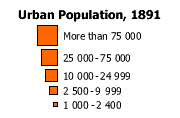|
|
||||||
Area units: Data units: |
 |
Only the legend for 1891 is shown here as an example. Urban Population 1825, 1851, 1871, 1891 |
Rural Population 1825, 1851, 1871, 1891 |
|
 |
Settlement |
| This layer shows Urban population symbols. This is the active layer. See explanation in Active Tools below. | |
|
This layer shows Modern Geography (current provincial and territorial boundaries, as well as selected cities), and is available for reference. |
| This is the active layer. Use the tools below to get data about the Urban centres represented by squares in this layer. | |
Identify: Click on the Identify tool, then click on the map on one of the squares, to pop up a box showing the name of the urban centre. |
|
Table: Click on the Table tool, then click or drag a rectangle on the map across one or more urban centres, to select them and pop up a table showing information about the selected features. See Table Fields below. |
|
| Query: Click on the Query tool, to pop up a Query box. Use the input boxes to specify range of population sizes, and click "Submit query" to select urban centres and pop up a table showing information about the selected features. See Table Fields below. |
| Urban centre | Urban centre name. Note: only centres totaling 1000 in 1891 are included. |
| Province | Province |
| Population 1825 | City/Town population in 1825. Note: a value of n/a is used where the city/town did not yet exist, had a population of less than 1000, or where data was not available. |
| Population 1851 | City/Town population in 1851. Note: a value of n/a is used where the city/town did not yet exist, had a population of less than 1000, or where data was not available. |
| Population 1871 | City/Town population in 1871. Note: a value of n/a is used where the city/town did not yet exist, had a population of less than 1000, or where data was not available. |
| Population 1891 | City/Town population in 1891. |
|
The population of Newfoundland (not mapped) grew at the same general rate as that of Eastern and Central Canada, from 102 000 in 1851 to 202 000 in 1891. The settled area, well established by 1836, remained restricted to the 'necklace of communities' that was tied to the coastal fishery. Population Distribution: 1825, 1851 |